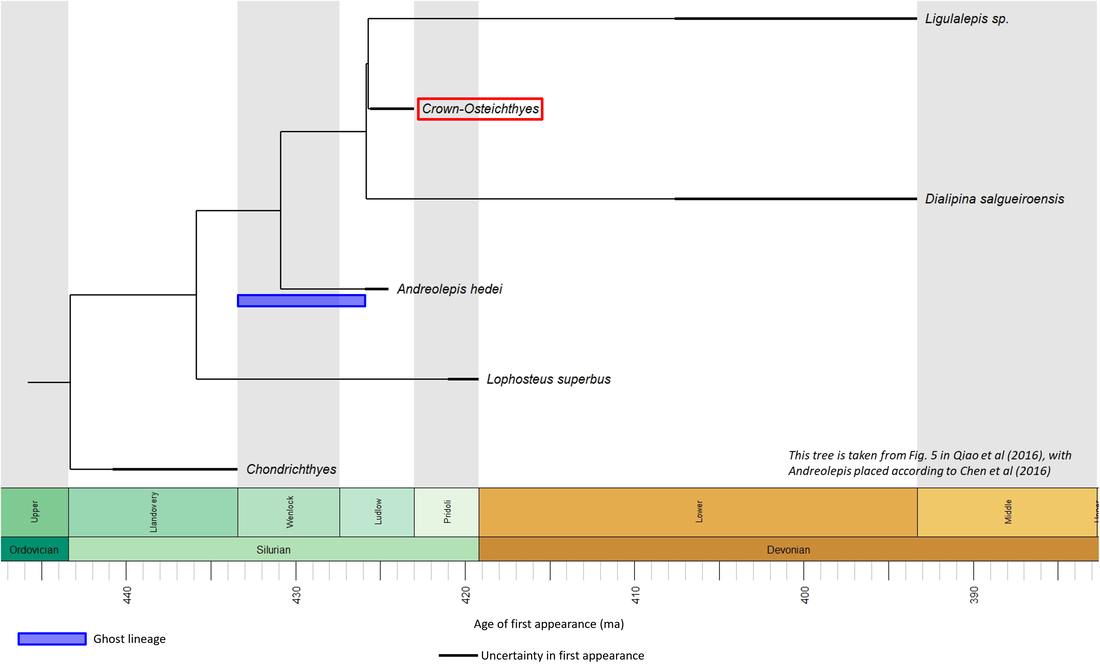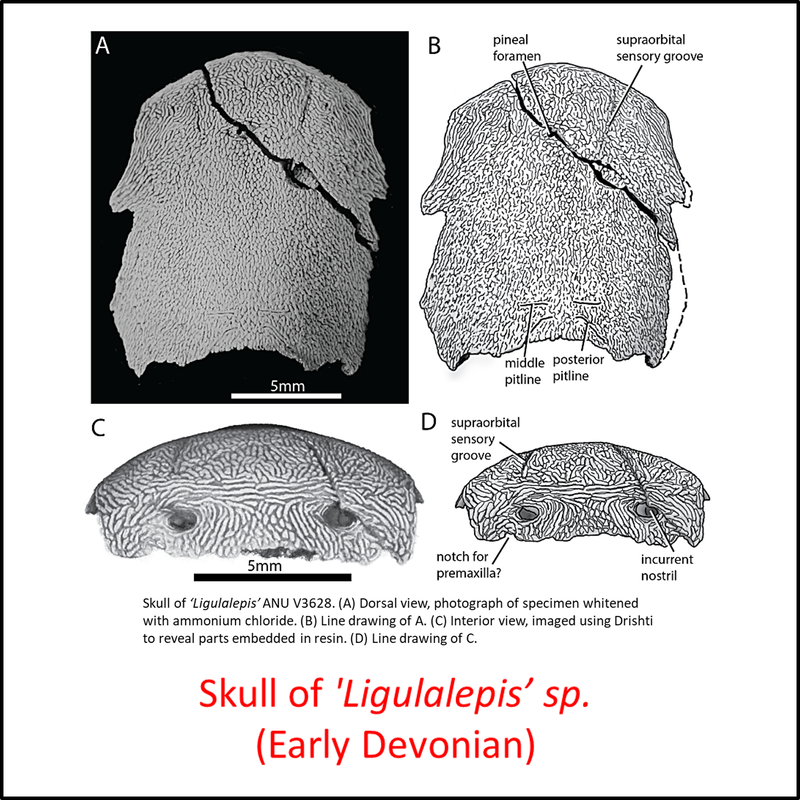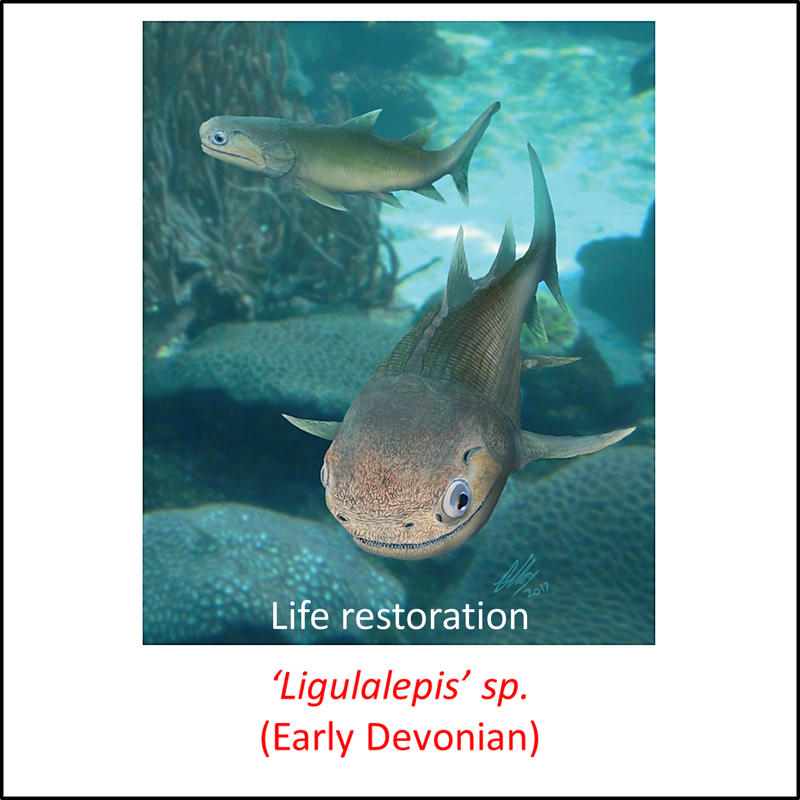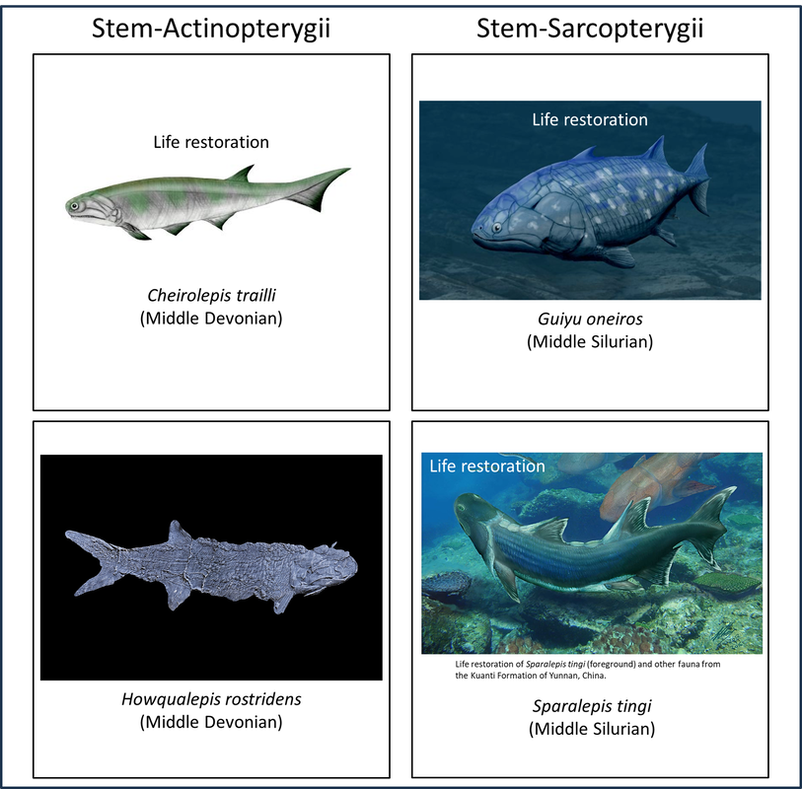This page covers the stem group of the bony vertebrates (Clade Euteleostomi, infraphylum Gnathostomata). Conventionally, the Euteleostomi have been distinguished from the bony fishes, or Osteichthyes. The difference is that the term Euteleostomi is applied to the entire sister clade of the Chondrichthyes (see phylogenetic tree on the Vertebrate stem group page), while the Osteichthyes are fishes and thus exclude the tetrapods. However, it is now common in current literature (e.g. Betancur-R et al, 2017) to include the tetrapods in the Osteichthyes and thus to consider the two terms as synonymous. We will use the more frequently used term Osteichthyes here. The primary characteristic of the Osteichthyes is a skeleton at least partly composed of true bone, as opposed to cartilage (Encyclopedia Britannica).
Very few stem-group osteichthyan fossils have been found to date, and there has been much debate about the origin of the clade. Even as recently as 2010, Friedman and Brazeau (2010) could write: “… we know almost nothing of the pattern of character acquisition leading to the crown, the most basic question related to osteichthyan origins that can be addressed with fossils.” However, since then new fossil discoveries and further phylogenetic analysis have led to more of a consensus on the phylogenetic relationships of the stem-Osteichthyes and their sister clade, the stem-Chondrichthyes.
Stem-group osteichthyans are mostly found as disarticulated scales, spines and fragments of dermal bone (Chen et al, 2016; 2017), although some skull remains have been found (e.g. ‘Ligulalepis’, Clement et al, 2018 and Dialipina salgueiroensis, Zhu et al, 2009). The phylogenetic relationships of the fossils now generally accepted to belong to the stem-Osteichthyes are illustrated in the following sparsely-populated phylogenetic time tree:
Very few stem-group osteichthyan fossils have been found to date, and there has been much debate about the origin of the clade. Even as recently as 2010, Friedman and Brazeau (2010) could write: “… we know almost nothing of the pattern of character acquisition leading to the crown, the most basic question related to osteichthyan origins that can be addressed with fossils.” However, since then new fossil discoveries and further phylogenetic analysis have led to more of a consensus on the phylogenetic relationships of the stem-Osteichthyes and their sister clade, the stem-Chondrichthyes.
Stem-group osteichthyans are mostly found as disarticulated scales, spines and fragments of dermal bone (Chen et al, 2016; 2017), although some skull remains have been found (e.g. ‘Ligulalepis’, Clement et al, 2018 and Dialipina salgueiroensis, Zhu et al, 2009). The phylogenetic relationships of the fossils now generally accepted to belong to the stem-Osteichthyes are illustrated in the following sparsely-populated phylogenetic time tree:
Figure 1. Time tree of the stem-Osteichthyes
The oldest known member of the stem-Osteichthyes is Andreolepis hedei, described from the Gogs locality near Lau (SE Gotland, Sweden), from the mid-Silurian (middle Ludlow) Upper Hemse Beds (Märss, 2001; Zhu et al, 2009)). No public-domain image is available for Andreolepis, and the only articulated fossils of the other stem group osteichthyans for which images are available in the public domain belong to the genus ‘Ligulalepis’. This is illustrated below (for a larger image, click on image):
Names in red indicate that the fossil is younger than the oldest known crown-group fossil.
Figure 2. Images of earliest stem-group and crown-group Osteichthyes
Some idea of the nature of the transition from the stem group to the crown group of the osteichthyans can be derived from a comparison of the above images with the examples of early crown-Osteichthyes shown below:
Figure 3. Examples of early crown-Osteichthyes
The osteichthyan stem line includes a ghost lineage (shown as a blue bar in Figure 1), because the oldest known stem-group chondrichthyan (of Early Silurian age; see page on the stem-Chondrichthyes) is somewhat older than the stem-group Osteichthyes, which are of late Silurian (Ludlow) and younger age. Given that the two stem groups must have appeared at the same time, the osteichthyan stem-group transition must also have begun in the Early Silurian. However, that transition did not last long compared with that of many other clades; its maximum duration is estimated to be only 18 million years.
References
Benton, M. J. (2015). Vertebrate Palaeontology - Fourth edition. John Wiley & Sons, 468 pages.
Betancur-R, R., Wiley, E. O., Arratia, G., Acero, A., Bailly, N., Miya, M., ... & Orti, G. (2017). Phylogenetic classification of bony fishes. BMC evolutionary biology, 17(1), 162.
Chen, D., Blom, H., Sanchez, S., Tafforeau, P., & Ahlberg, P. E. (2016). The stem osteichthyan Andreolepis and the origin of tooth replacement. Nature, 539(7628), 237-241.
Chen, D., Blom, H., Sanchez, S., Tafforeau, P., Märss, T., & Ahlberg, P. E. (2017). Development of cyclic shedding teeth from semi-shedding teeth: the inner dental arcade of the stem osteichthyan Lophosteus. Royal Society Open Science, 4(5), 161084.
Clement, A. M., King, B., Giles, S., Choo, B., Ahlberg, P. E., Young, G. C., & Long, J. A. (2018). Neurocranial anatomy of an enigmatic Early Devonian fish sheds light on early osteichthyan evolution. Elife, 7, e34349.
Friedman, M., & Brazeau, M. D. (2010). A reappraisal of the origin and basal radiation of the Osteichthyes. Journal of Vertebrate Paleontology, 30(1), 36-56.
Lu, J., Giles, S., Friedman, M., & Zhu, M. (2017). A new stem sarcopterygian illuminates patterns of character evolution in early bony fishes. Nature communications, 8(1), 1932.
Märss, T. (2001, September). Andreolepis (Actinopterygii) in the upper Silurian of northern Eurasia. In Proceedings of the Estonian Academy of Sciences: Geology (Vol. 50, pp. 174-189).
Qiao, T., King, B., Long, J. A., Ahlberg, P. E., & Zhu, M. (2016). Early gnathostome phylogeny revisited: multiple method consensus. PloS one, 11(9), e0163157.
Zhu, M., Zhao, W., Jia, L., Lu, J., Qiao, T., & Qu, Q. (2009). The oldest articulated osteichthyan reveals mosaic gnathostome characters. Nature, 458(7237), 469-474.
Betancur-R, R., Wiley, E. O., Arratia, G., Acero, A., Bailly, N., Miya, M., ... & Orti, G. (2017). Phylogenetic classification of bony fishes. BMC evolutionary biology, 17(1), 162.
Chen, D., Blom, H., Sanchez, S., Tafforeau, P., & Ahlberg, P. E. (2016). The stem osteichthyan Andreolepis and the origin of tooth replacement. Nature, 539(7628), 237-241.
Chen, D., Blom, H., Sanchez, S., Tafforeau, P., Märss, T., & Ahlberg, P. E. (2017). Development of cyclic shedding teeth from semi-shedding teeth: the inner dental arcade of the stem osteichthyan Lophosteus. Royal Society Open Science, 4(5), 161084.
Clement, A. M., King, B., Giles, S., Choo, B., Ahlberg, P. E., Young, G. C., & Long, J. A. (2018). Neurocranial anatomy of an enigmatic Early Devonian fish sheds light on early osteichthyan evolution. Elife, 7, e34349.
Friedman, M., & Brazeau, M. D. (2010). A reappraisal of the origin and basal radiation of the Osteichthyes. Journal of Vertebrate Paleontology, 30(1), 36-56.
Lu, J., Giles, S., Friedman, M., & Zhu, M. (2017). A new stem sarcopterygian illuminates patterns of character evolution in early bony fishes. Nature communications, 8(1), 1932.
Märss, T. (2001, September). Andreolepis (Actinopterygii) in the upper Silurian of northern Eurasia. In Proceedings of the Estonian Academy of Sciences: Geology (Vol. 50, pp. 174-189).
Qiao, T., King, B., Long, J. A., Ahlberg, P. E., & Zhu, M. (2016). Early gnathostome phylogeny revisited: multiple method consensus. PloS one, 11(9), e0163157.
Zhu, M., Zhao, W., Jia, L., Lu, J., Qiao, T., & Qu, Q. (2009). The oldest articulated osteichthyan reveals mosaic gnathostome characters. Nature, 458(7237), 469-474.
Images - Stem-group osteichthyans
- Figure 2 ('Ligulalepis', fossil): Open Access article Clement, A. M., King, B., Giles, S., Choo, B., Ahlberg, P. E., Young, G. C., & Long, J. A. (2018). Neurocranial anatomy of an enigmatic Early Devonian fish sheds light on early osteichthyan evolution. Elife, 7, e34349.
- Figure 2 ('Ligulalepis', life restoration): Open Access article Clement, A. M., King, B., Giles, S., Choo, B., Ahlberg, P. E., Young, G. C., & Long, J. A. (2018). Neurocranial anatomy of an enigmatic Early Devonian fish sheds light on early osteichthyan evolution. Elife, 7, e34349.
- Figure 3 (Cheirolepis trailli): Nobu Tamura under a Creative Commons 3.0 Unported (CC BY-NC-ND 3.0) license
- Figure 3 (Howqualepis rostridens): Copyright Museums Victoria / CC BY (Licensed as Attribution 4.0 International)
- Figure 3 (Guiyu oneiros): Nobu Tamura under a Creative Commons 3.0 Unported (CC BY-NC-ND 3.0) license
- Figure 3 (Sparalepis tingi): Open Access article Choo, B., Zhu, M., Qu, Q., Yu, X., Jia, L., & Zhao, W. (2017). A new osteichthyan from the late Silurian of Yunnan, China. PloS one, 12(3), e0170929.



